Director’s Introduction
Taft Armandroff, Director, WMKO
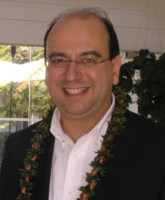
The entire U.S. astronomy enterprise has been engaged this year in the Astro2010 Decadal Survey process. Many members of the Keck observing community are devoting substantial time and energy to service on various panels and sub-panels of Astro2010.
For over a year, the Keck Science Steering Committee and Keck Observatory leadership have been working on an updated scientific strategic plan for the Observatory. The existing draft plan, which has been circulated to Keck Observatory’s user community, has positioned us well for providing input to the Astro2010 process.
Keck Observatory leadership and the Keck Science Steering Committee, working with interested community members, have developed four submissions to Astro2010. Our goal in these submissions is to clarify future opportunities and plans for the continued scientific productivity and development of cutting-edge observing capabilities at Keck Observatory. More than ever, the Observatory is dependent on federal funding and serves as a key element of the U.S. ground-based observing system. Therefore, participation in these broad community planning processes is important.
For the Astro2010 Programs Subcommittee’s request for information, Keck Observatory submitted the following two activity papers:
- The W. M. Keck Observatory: A Private/Public Partnership Enabling Frontier Astrophysical Advances in the Coming Decade
- W. M. Keck Observatory’s Next Generation Adaptive Optics Facility
In response to the call for Astro2010 State of the Profession position papers, Keck Observatory prepared the following two papers:
- The Role of the W. M. Keck Observatory in U.S. Astronomy
- The Value of the Keck Observatory to NASA and Its Scientific Community
One other State of the Profession position paper was written jointly with other facilities advancing interferometry:
All of these submissions have been made available to the Keck Observatory user community and are featured on our top-level web page. If you have not done so already, I urge you to read them.
The annual meeting of the Keck Observatory user community will be held at Caltech on Thursday September 17. You are encouraged to attend and to present your latest scientific results from the Keck telescopes. Please register at the Keck Science Meeting web site. The meeting will also include an update from me on recent achievements and future initiatives at Keck Observatory.
The annual Keck Scientific Strategic Planning Meeting will take place on Friday September 18. The Keck Science Steering Committee and the WMKO, Caltech, and U. C. Observatory Directors will present discussions of the Keck scientific strategic planning process, the draft Keck Observatory Scientific Strategic Plan, outlooks for resources for new initiatives, our efforts to engage with the Astro2010 process, and the relationship between Keck and TMT in the next 10-20 years. Again, all Keck users are encouraged to participate. Both meetings will take place in Pasadena at Caltech’s new Cahill Center. «
Operations Notes
Bob Goodrich, Observing Support Manager, WMKO
Some smaller tidbits of news from around the Observatory:
HIRES iodine cell scanned. The exoplanet teams using HIRES have long desired a higher-resolution spectral scan of the iodine cell to improve their spectral modeling analysis. The previous scan of the cell had a resolution of only about R = 140,000. In Fall 2008, Debra Fischer and Paul Butler independently proposed for and were awarded invaluable time on the Fourier Transform Spectrometers (FTS) at Pacific Northwest National Laboratory (PNNL) in Washington state and the National Institute of Standards and Technology (NIST) in Washington, D. C., respectively, for the purpose of obtaining spectral scans at resolutions of 500,000 < R < 1,000,000. During a gap of just over 2 weeks between HIRES observing runs in March 2009, the iodine cell was removed from the summit and transported to the UCO/Lick Observatory electronics laboratory. There, HIRES P.I. Steven Vogt and Development Engineer Barry Alcott carefully prepared the iodine cell for standalone operation before sending it off to PNNL. Once at PNNL, Debra Fischer worked with Thomas Blake (PNNL) over 3 days to scan the cell before sending it off to Paul Butler at NIST. After another 3 days of FTS scanning, the cell was returned to UCO/Lick where Barry Alcott once again prepared it for operation inside HIRES. The iodine cell was then shipped to Hawaii and reinstalled into HIRES with two days to spare before the next exoplanet run. The 10,000-mile odyssey of the iodine cell could not have succeeded without the dedicated efforts of Debra Fischer, Paul Butler, Steve Vogt, Barry Alcott, Mike Bolte, Geoff Marcy, and the highly professional staffs of PNNL and NIST. The independent FTS scans are now in use by the exoplanet teams and available to the Keck user community. Please contact your WMKO Support Astronomers at instrument@keck.hawaii.edu to obtain the FTS scan data.
KOA offers extracted HIRES spectra. The Keck Observatory Archive (KOA) now provides extracted spectra for all HIRES data in the archive. (Previously the extracted spectra were only available for images taken after 2004 August, when the detector was upgraded to a 3-CCD mosaic.) The team continues to upgrade the functionality of the archive; look for a new tool for interacting with the extracted spectra in upcoming months. There will also be a poster at the Keck Science Meeting in September with more information.
NIRC’s retirement nears. The venerable NIRC (Near-Infrared Camera) instrument has had a long and successful career producing cutting-edge science here at the Observatory. Unfortunately, we must retire NIRC to make room on the Keck I Nasmyth deck for MOSFIRE , an exciting new instrument slated to arrive in early 2010. NIRC will no longer be available as of semester 2010A, which begins in February 2010. As we bid NIRC a fond farewell, we salute the instrument builders and the observers who have done such excellent science with NIRC over the years.
Segment recoating resumes in 2009B. For a number of years we’ve put our primary mirror segment recoating (“segment exchange”) effort on hold in order to understand what has been causing the microfractures seen in some of the segments. We wanted to avoid possible damage to the optics through extra thermal and handling stress during the exchange and recoating process. Starting in August 2009, we have resumed coating segments on Keck II to rejuvenate the high-quality optical surfaces of the primary mirror. We plan to begin cautiously, and will hold a review of how we handle segments to minimize any risk to those valuable hexagons. Once the Keck II primary is recoated, we will concentrate on Keck I.
During the hiatus in segment recoating, the Observatory took the opportunity to refurbish and improve the summit coating facility. WMKO Operations Engineering Manager Craig Nance led a team of engineers in redesigning the control system, milling the chamber flanges for a better seal, and adding ports that will allow future expansion of the coating chamber. We look forward to seeing the high-quality coatings on both Keck primary mirrors fully restored with the revamped chamber.
Keck access to Gemini/Subaru continues. The Keck-Gemini and Keck-Subaru observing time exchange programs will continue in observing semester 2010A. The Gemini trade system is unchanged from past semesters, but the Subaru trade now provides access to a larger suite of Subaru instruments. In addition to Suprime-Cam and MOIRCS, which have been available in past semesters, the Keck community will now have access to FOCAS, HDS, IRCS (featuring a 188-element natural-guide-star adaptive optics system) and COMICS. We encourage observers to take advantage of the added scientific capability these time trades provide. For further information on time exchange programs, please refer to our web page on Applying for Keck Telescope Time.
Waimea dining guide. The dining-out situation in Waimea changes regularly as restaurants come and go, change hands, modify menus, and alter hours. WMKO Administrative Assistant Gloria Martin tries to keep abreast of these changes, updating the restaurant menu book in each Remote Ops room for the convenience of observers. The revised book has a listing of restaurants and locations in Waimea Town along with resort information. Gloria has also created a new Web site that includes a Google map of town showing restaurants and other important landmarks (http://www2.keck.hawaii.edu/observing/visitor/town.html), plus an on-line restaurant guide (http://www2.keck.hawaii.edu/observing/visitor/rest.html). To help us keep this information current, we encourage observers to supply us with current copies of restaurants’ menus. Please feel free to drop off new menus on Gloria’s desk in the Kohala wing lobby of Keck HQ. «
OSIRIS Experiencing Thermal Problems
Jim Lyke, Support Astronomer, WMKO
OSIRIS, the Observatory’s integral-field near-IR spectrograph and imager behind the Keck II adaptive optics system, is having what could charitably be called a “trying” year. For much of 2009, the OSIRIS dewar has experienced problems maintaining its desired cryogenic temperature and we are currently undertaking our third OSIRIS servicing mission of the calendar year in an attempt to fix it. Initially, the cooling problems were sporadic and a February servicing mission found evidence of an intermittent thermal contact. Once that was fixed, we cooled OSIRIS partially, but it was immediately evident that cooling problems persisted. In March, we replaced the OSIRIS closed-cycle refrigerator (CCR) cold head with a rebuilt unit from the manufacturer, CTI. It initially appeared as though that cold head unit was defective. From April through July the dewar temperature had risen slowly but steadily, indicating a continuing problem. The temperature progression and its effect on noise performance are documented on the OSIRIS News Page. In late July, the temperature rise accelerated and we removed OSIRIS from service until we could repair it. As of this writing, we have again serviced OSIRIS to change out the cold head with a brand new unit from CTI; however, the dewar continues to experience trouble cooling. As of early September we have returned OSIRIS to service and will continue to address the thermal problems until they are fixed. «
WMKO Upgrades LRIS Red Detector and Offset Guider
Marc Kassis, Support Astronomer, WMKO
In June 2009, WMKO and UCO/Lick commissioned the new red-side dewar for LRIS, featuring a detector mosaic that substantially improves the performance of the red side. The scope of the project includes not only upgrades to the detector but also improvements to the user interface, instrument operational procedures, and data reduction capabilities.
The heart of the project is the new red dewar, which replaces the original monolithic Tektronix/SITe 2k×2k CCD with a mosaic of two 2k×4k high-resistivity CCDs from LBNL. These new devices offer lower read noise than their predecessors as well as higher quantum efficiency in the red, extending the LRIS wavelength range into the I and Z bands. They also provide a greater detector area, which allows the red side to image a 25% greater wavelength range in a single spectrum. With a significantly finer pixel scale than the original CCD, the mosaic will typically oversample delivered images and spectra. Moreover, the new mosaic has a much flatter focal surface than its predecessor, which yields more uniform focus across the field of view. Fortunately, the new LRIS red mosaic eliminates the substantial fringing exhibited by the original detector, long the bane of red-side observations.
While the new detectors offer a number of benefits, they also have some specific cosmetic defects including traps, and a response non-uniformity at the edges of the device caused by the way the devices are mounted (called the “tape effect”) which can be removed with careful flat fielding. In addition, the new CCDs show high rates of cosmic-ray events. To get the most out of the new red-side detector, we suggest that observers adopt the following observing strategies:
- To reduce the contribution of read noise in the data, read out the red detector with binning enabled in the column and/or row directions.
- To enable effective cosmic ray rejection, limit exposure times to under 20 min and, when possible, acquire multiple exposures.
The new red mosaic includes a gap between the detectors which is slightly larger than the corresponding gap in the blue mosaic. Fortunately, care was taken to align the red dewar such that the blue and red gaps coincide in the image plane. The larger gap slightly reduces the available area for slits in the focal plane, and Prof. Judy Cohen (Caltech) has kindly updated the Autoslit slitmask design software program for LRIS to account for the new red gap.
The upgrade has affected not only the hardware on LRIS but also the software. The venerable FIGDISP image displays have been replaced by the widely-used ds9 image display tool, a major improvement. The two image displays now have the same orientation and the red and blue window placement was swapped so that wavelength increases from left to right. The FITS files generated by both sides are now written in standard multi-HDU (header data unit) FITS format rather than “simple FITS” format. To help observers deal with the new data format, we are providing both IRAF- and IDL-based routines for assembling the subimages into a single 2-D array. Furthermore, the revised slitmask alignment software now parses the new image format and includes several new tasks for completing mask alignment more efficiently.
Yet more changes to LRIS are in store for the near future under the auspices of the Multi-function Acquisition, Guiding and Image Quality monitoring (MAGIQ) project. Following the successful upgrade of the LRIS slit guider earlier this year, we are currently replacing the old movable guider with a fixed-position offset guider. Compared to the old movable guider, the new MAGIQ offset guider will feature greater sensitivity, lower flexure, and a wider field of view. «
New PIO Ashley Yeager joins Observatory’s Advancement Team
Debbie Goodwin, Director of Advancement, WMKO
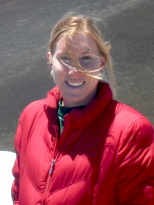
Welcome to Ashley Yeager, the Observatory’s Public Information and Outreach (PIO) Officer who joined the Keck Ohana in February, 2009. Ashley was born and raised in Pennsylvania; her parents are both high school science teachers. She graduated from the University of Tennessee, Knoxville with a degree in communications and information in 2007 and earned a master’s degree in science writing from the Massachusetts Institute of Technology in 2008. Before joining the Observatory she was a writer for both Nature and Science News, based in Washington, D. C. She was the recipient of an MIT Science Writing Fellowship, the University of Tennessee Torchbearer award, and the J. Paul Blakely Scholarship for Excellence in Science Writing. She is also an accomplished competitive swimmer and triathlete.
Ashley has a palpable passion for communicating astronomy research to the public, guided by her work at the Smithsonian Air and Space Museum, at the Oak Ridge National Laboratory, and with astronomer Vera Rubin, from the Carnegie Institution of Washington, who encouraged Ashley to follow her dreams when the two worked together on an oral history project with the American Institute of Physics.
Ashley’s priorities at Keck Observatory are to strengthen strategic communications and manage all of the Observatory’s outreach activities. She is responsible for the Observatory’s press releases, web presence, e-magazine Cosmic Matters, and for optimizing new media opportunities being developed under the Keck Nation program. Ashley coordinates public lectures held monthly at Waimea headquarters and is also our key contact for all external media requests.
To support Keck Observatory’s commitment to “share our discoveries, inspiring the imaginations of all,” Ashley recently brought together vision, resources and the Keck Outreach Team to organize Keck’s first Keiki Cosmic Camp in August engaging North Hawai’i youth in a hands-on exploration of astronomy.
Contact Ashley by telephone at 808-881-3827 or via email at ayeager@keck.hawaii.edu to share ideas and for your Observatory communications needs or please stop by her office when you are visiting Keck headquarters. «
Keck I Laser Guide Star Adaptive Optics System Nears Completion
Jason Chin, Senior Electronics Engineer, WMKO
Randy Campbell, Support Astronomer, WMKO
For several years, one of our highest-priority instrumentation projects at WMKO has been to develop and deploy a state-of-the-art Laser Guide Star Adaptive Optics (LGS AO) system for the Keck I telescope. Although similar in nature to the corresponding laser system in use on Keck II since 2004, the new system will offer three key advantages: solid-state operation which offers higher reliability compared to dye-based lasers, a center-mounted launch telescope to reduce the “parallax effect” that degrades laser spot quality in side-mounted launch telescopes such as on the Keck II system, plus a brighter and more concentrated laser guide star image which enables more accurate correction for atmospheric blur. Once this highly anticipated project is completed, we will have two telescopes capable of supporting LGS science.
We are pleased that the three major new components of the system have recently passed acceptance tests, paving the way for the project to proceed to the installation phase. The three components are the Lockheed Martin Coherent Technology (LMCT) laser system, the photonic crystal fiber for transmitting the laser beam from the laser enclosure to the launch telescope, and the Galileo Avionica Launch Telescope that will project the 50 cm-diameter collimated beam from behind the Keck I f/15 secondary mirror into the atmosphere.
The LMCT solid state laser (Figure 1) underwent acceptance testing in July 2009 and passed a 150 hr burn-in test in August in preparation for delivery to Keck headquarters this fall. While at HQ, the laser will undergo a series of post-delivery tests to ensure that it was not damaged during transport from Colorado. The laser effort at HQ will include integration with the Keck telescope control system. Once the laser is fully tested and integrated, we expect to deliver it to the summit sometime in late 2009.
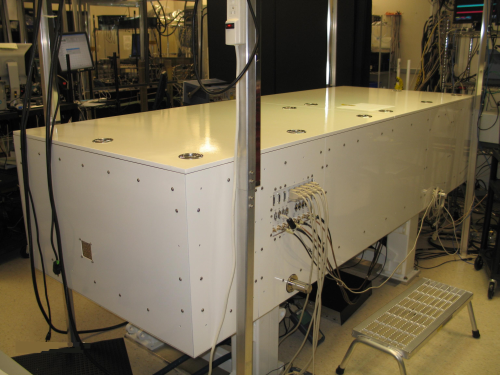
|
Figure 1. Keck I solid-state laser assembly undergoing acceptance testing at the Lockheed Martin Coherent Technology laboratory in Colorado.
The Launch Telescope (Figure 2) completed its factory acceptance testing at Florence, Italy-based Galileo Avionica in December 2008. After being delivered to Hawaii, the launch telescope was installed and aligned on the Keck I telescope, joining the Beam Transport Optical Bench (Figure 3) that steers the laser beam. Telescope alignment has been tested using incoming starlight and optical quality has been tested in the lab. The launch telescope has passed its acceptance tests and should be ready for laser light.
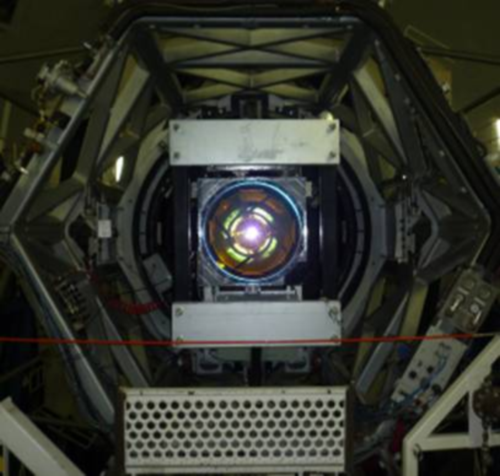
|
Figure 2. The Keck I laser launch telescope (LT), viewed from the sky perspective, mounted to the f/15 secondary module. The light in the center is the reflection of the camera flash.
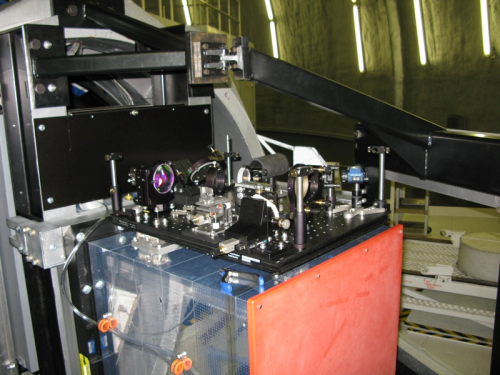
|
Figure 3. Beam Transport Optical Bench (BTOB) mounted adjacent to the launch telescope, which is inside its enclosure with the removable orange cover, on the back (sky side) of the Keck I f/15 secondary module
The photonic crystal fiber, which transmits the laser light from the laser service enclosure to the launch telescope, was delivered from Mitsubishi Industries in the summer of 2009. The fiber, beam injection module, and the beam transport optical bench have been undergoing tests at Keck headquarters in Waimea. Low-power tests are now complete and the fiber is ready for high-power tests, which await the delivery of the LMCT laser.
While the new systems are being tested and installed, the rest of the adaptive optics system needed for full LGS AO control is undergoing a series of daytime and night on-sky testing. These tests, using natural guide stars, will verify the functionality of the hardware and software modifications made in preparation for the LGS system.
We anticipate that by the end of 2009, the Keck I LGS AO system will join the three other existing laser systems (Keck II, Gemini, and Subaru) atop Mauna Kea. OSIRIS, the initial science instrument to be used behind the Keck I LGS AO system, will eventually be moved from Keck II once the Keck I LGS AO system is fully commissioned. OSIRIS will thus remain on Keck II throughout the full 2010A observing semester.
The Observatory is grateful to acknowledge the National Science Foundation for grants supporting development and construction of the Keck I laser. Funding for the integration of the Keck I LGS AO system was generously provided by the Mt. Cuba Astronomical Foundation and the Change Happens Foundation. «
Back Issues
Please see the Keck Observers’ Newsletter Archive.
